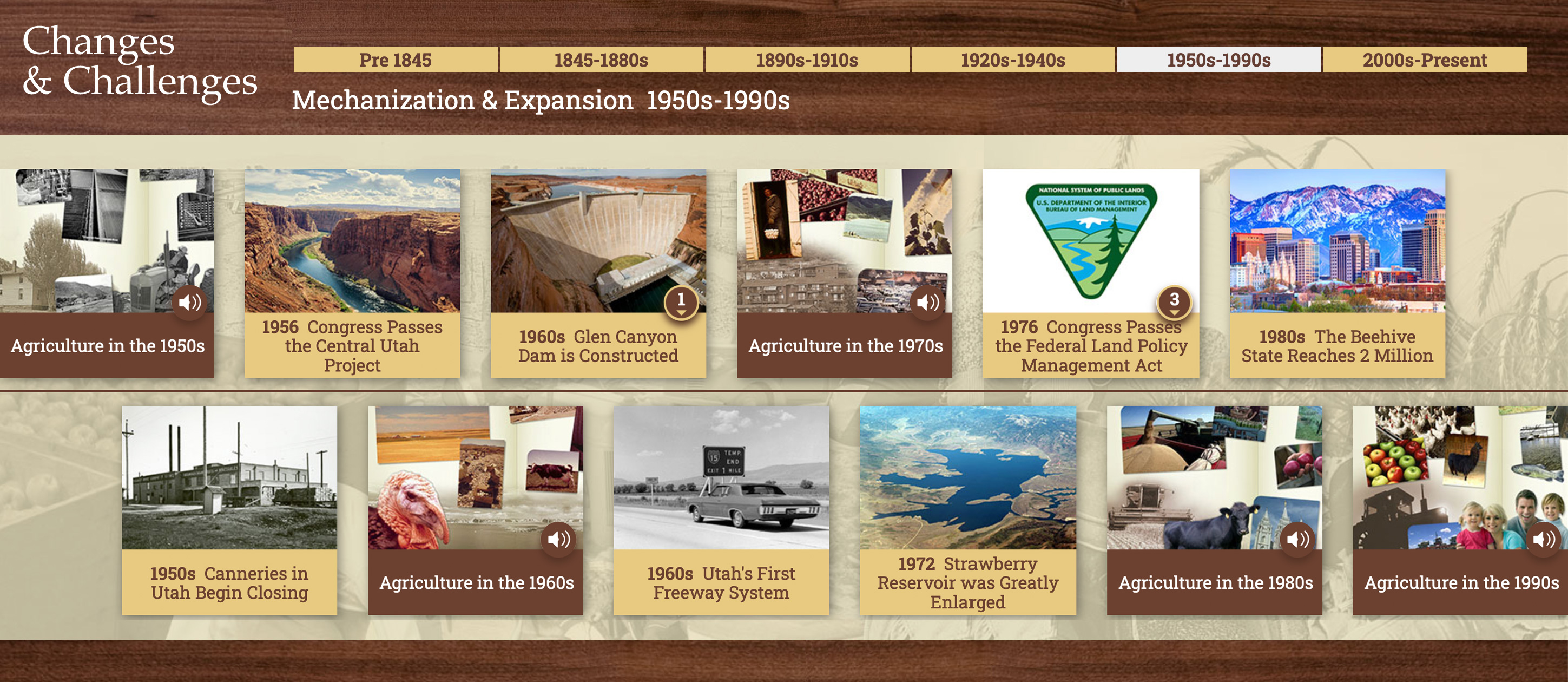Utah Studies
Changes & Challenges (1960s-1970s): Expansion and Prosperity, Big Farms, Big Government

Grade Level(s)
6 - 8
Purpose
Students will observe the changes that led to modern agricultural trends still seen in Utah and will understand the connection between the environment, farmland, water, and themselves.
Estimated Time
45 minutes
Materials Needed
- Changes and Challenges Interactive Timeline
- The Great Depression article
- The Sugar Industry in Utah article
- Central Utah Project article
- Norbest History article
- EPA History Timeline
Essential Files (maps, charts, pictures, or documents)
Vocabulary Words
- Environmental Protection Agency (EPA): independent agency in the executive branch charged with controlling and abating environmental pollution
Background Agricultural Connections
Agriculture in the 1960s, Narrative
By 1960 only about a quarter of Utahns lived in rural areas, and the number of farms dropped to 19,000. The average farm size jumped to 716 acres. Farmland in Utah increased to 13.6 million acres, the largest amount in state history. Cattle and milk remained the most important livestock products; while hay, wheat, and sugar beets remained the state's most significant crops. Mechanized planting and harvesting in the 1960s improved sugar beet production, but Utah farmers found it hard to compete with cane sugar from Hawaii and overseas. Turkey and onion production also increased during the 1960s, but the demand for many Utah fruits declined and more canneries closed. The Central Utah Project built the Steinaker Dam, Flaming Gorge Dam, Arizona's Glen Canyon Dam (which created Lake Powell), Joe's Valley Reservoir (an Emery County project), and the Uintah Unit, which brought water to Indian and non-Indian lands in the Uintah Basin.
Agriculture in the 1970s, Narrative
In 1970 over 80 percent of Utahns lived in urban areas. The number of farms fell to 14,100. Average farm size grew to 936 acres, but population growth reduced Utah farmlands to about 13 million acres. By mid-decade the average farm size reached a record 1,000 acres as farm numbers kept declining. Cattle and milk remained Utah's most important livestock products, while hay and wheat were still the state's major crops. During the 1970s apple and tart cherry production increased as new orchards were planted on cheaper lands away from urban growth. Egg production also increased during the decade, but turkey production decreased. Mink pelt prices declined early in the 1970s but rose again by the end of the decade, saving many skilled breeders. Strawberry Reservoir was greatly enlarged during the 1970s under the Central Utah Project and its water piped through the Wasatch Mountains into central Utah via the new 6.5-mile Syar Tunnel. In 1970 the U.S. Environmental Protection Agency was established and national pollution control laws were enacted that would shape the future of Utah agriculture.
Changes & Challenges Unit
This lesson is one in a series of lessons designed to accompany the Utah Studies course taught throughout Utah. The unit explores the settlement of Utah, the self-sufficient nature of the state's people, and the future of Utah agriculture and agricultural land. The Changes and Challenges Interactive Timeline accompanies the following lessons:
- Changes & Challenges (1840s-1880s): Era of Self-Sufficiency
- Changes & Challenges (1890s): Utah Becomes a State
- Changes & Challenges (1900s): Boom Time for Agriculture
- Changes & Challenges (1910s): The Boom Continues
- Changes & Challenges (1920s-1930s): Agricultural Hard Times and The Great Depression
- Changes & Challenges (1940s): World War II and Revival
- Changes & Challenges (1950s): Mechanization and Science
- Changes & Challenges (1960s-1970s): Expansion and Prosperity, Big Farms, Big Government
- Changes & Challenges (1980s): Recession, Expansion, and Utah Wheat
- Changes & Challenges (1990s): Products of Utah Travel Worldwide
- Changes & Challenges (2000s): Recession and Expansion
Interest Approach – Engagement
- View the Mechanization and Expansion (1950s-1990s) Era on the Changes and Challenges interactive timeline with your students.
- Use the following Procedures section as a guide to explore the concepts in the multimedia presentation.
Procedures
Agriculture in the 1960s: Expansion and Prosperity
- On the Changes and Challenges Interactive Timeline, allow your students to listen to the narrative on the tile captioned, "Agriculture in the 1960s."
- Explain to students that between 1963 and 1975, 388 men and one woman from Utah were killed or listed as missing in action in Vietnam. During the war, the Utah economy prospered. Discuss the associated question:
- Why would war bring prosperity to Utah farmers?
- Explain to students that over the decades, the number of harvested acres of sugar beets fell from over 100,000 to less than 40,000. But greater mechanization increased the number of tons of beets harvested per acre. Discuss the associated question:
- Why might the number of acres of beets planted by farmers have dropped by the 1960s? (Competition from cane sugar, C&H – California and Hawaiian Sugar Company)
- Have students read the article The Sugar Industry of Utah.
- Remind students of the importance of irrigation to Utah agriculture. Direct students to the main event on the interactive timeline titled, "Congress Passes the Central Utah Project." Explain that the Central Utah Project built more dams and irrigation projects around the state. Ask students to read the article Central Utah Project individually. Discuss the associated questions:
- This project has not always been popular with everyone. Why were farmers, boaters, fishermen, and cities in favor of these projects?
- Why would other groups disagree with these projects?
- Ask your students to identify their water source and trace it back to it origin. For example, does their household water come from a well (ground water)? If so, what watershed are they par of (see Utah Major Watersheds)? Is their water part of the surface system? If so, what reservoir do they get their water from? Which river feeds the reservoir (see Utah Lakes, Rivers, and Water Resources)?
- Explain to students that turkey production in Utah took off in the 1920s when farmers were looking for new cash products to raise. Major expansion occurred in the 1970s. Norbest, a successful Utah turkey cooperative, evolved as an association of many Utah turkey producers. Ask students to read the attached Norbest History article. Discuss the following questions:
- What were the original goals of this organization? (Assist turkey producers with marketing)
- How well has it accomplished its mission? (Norbest has been very successful and is Utah's largest turkey-producing and processing company today)
- What has Norbest done to encourage people to eat more turkey? (Develop simple, convenient turkey products, provide turkey for Thanksgiving on the International Space Station)
Agriculture in the 1970s: Big Farms, Big Government

- On the Changes and Challenges Interactive Timeline, allow your students to listen to the narrative on the tile captioned, "Agriculture in the 1970s."
- Explain to students that the United States Environmental Protection Agency (EPA) was established in 1970. Its mission is to protect human health and to safeguard the natural environment—air, water, and land—upon which life depends
- Introduce students to the EPA History Timeline.
- Divide the class into five groups. Assign each group a decade from the EPA's history: 1968-79,1980-89, 1990-99, 2000-09, 2010-present.
- Explain that each individual in each group should select an EPA History Timeline event or issue from their assigned decade would or could have affected Utah farmers. Ask students to consider the following questions and then present their EPA decade to the class:
- How do you think the event could have affected Utah farmers?
- What concerns might Utah farmers and ranchers have when new environmental laws and regulations are passed?
Concept Elaboration and Evaluation
After conducting these activities, review and summarize the following key concepts:
- The consolidation of agriculture during this period meant that farms got bigger and the number of farms and farmers decreased.
- Agriculture relies on natural resources, like water, which are both used and conserved by farmers.
- Agricultural conservation practices can provide benefits to farmers, but conservation also presents challenges.
Suggested Companion Resources
- Changes and Challenges (Activity): The Cox and Gossner Family Histories (Activity)
- America's Heartland: Sweet Beets (Multimedia)
- Feeding the World and Protecting the Environment (Multimedia)
- Agricultural News (Website)
- Science in Your Watershed (Website)
Author(s)
Debra Spielmaker
Organization Affiliation
Utah Agriculture in the Classroom
-
Investigate the past and present role of agriculture in Utah. Meeting one or more of the following indicators:
- Identify the importance of farming and ranching to Utah's economy.
- Explain the impact the Great Depression on farmers and agriculture.
- investigate how agriculture has diversified and improved over time.
- Examine the cultural legacy of agriculture in Utah.
-
Investigate the relationship between physical geography and Utah's settlement, land use, and economy. Meeting one or more of the following indicators:
- Read and interpret a variety of maps.
- Identify the physical features and regions of Utah.
- Compare and contrast the relationship between physical features and regions to settlement, land use, and the economy.
-
Assess how natural resources sustain and enhance people's lives. Meeting one or more of the following indicators:
- Recognize the impact of water, minerals, wildlife, and forests on people.
- Distinguish between renewable and non-renewable resources.
- Analyze how natural resources improve the quality of life.
- Assess the importance of protecting and preserving natural resources.
-
Examine how people affect the geography of Utah. Meeting one or more of the following indicators:
- Identify Utah's counties and cities.
- Assess how people change the landscape.
- Examine how altered landscapes affect people.


